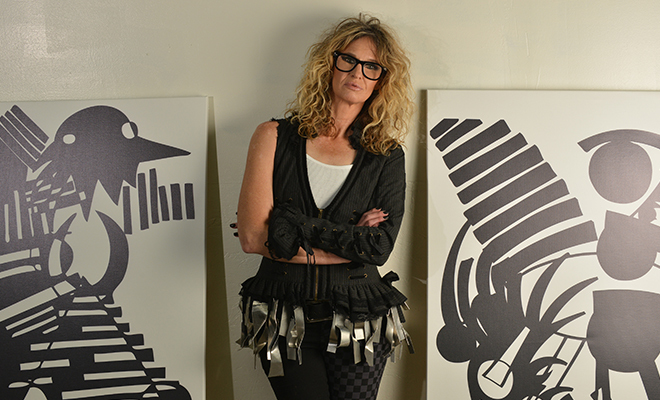 lightbox images
lightbox images
Leigh Erceg: A Dancer Who Sees Her Music
Leigh Erceg is not only one of a kind, but she is potentially once in a lifetime in terms of being the only woman known to the medical community with two rare conditions of the brain following a traumatic brain injury in October 2009. Leigh’s injury resulted in a series of jaw-dropping revelations and experiences of the sort movies are made from.
Her post-accident condition is so rare that even the most esteemed medical professionals and researchers had to conduct appreciable scientific studies and brain scans to ultimately diagnose her with acquired savant syndrome, which creates enhanced cognitive ability in the disciplines of art, physics, literature and music. This diagnosis also presented with synesthesia, which is described as a mixing of the senses, creating a world where one sees a sound or hears a color as a series of letters and numbers. It’s as if Leigh is living with all of her senses not only fully engaged, but on full throttle, dancing with one another to a tune others cannot hear. Imagine being able to taste light or see the music. Leigh can. Most people who undergo a brain injury that results in Leigh’s condition come back with one single skill, but Leigh came back with four skills. She is a master of poetry, physics, music and art.
The Beginning of Radical Change
On that day in 2009, Leigh, now 47, sustained a horrific head injury while working on a family ranch in Maybell, Colorado. Simply tending to the duties of feeding some chickens, she lost her balance and fell into a ravine, suffering significant spine and brain injuries. That fall essentially ended her life, not in terms of mortality, but in terms of who she was inside her brain.
Before the accident, Leigh was, by all accounts, highly extroverted, an accomplished athlete, a “roll up her sleeves and wipe the sweat off her brow” tomboy who studied a variety of subjects, enjoyed going out on dates and working on the family ranch in northwestern Colorado. The intellectual disciplines of physics, science, art and music were never a part of her dynamic. As she emerged from the other side of her accident and into recovery, Leigh found herself hungry for the arts, passionate about music, and ready to devour mathematical equations and theorems in a way that would make Stephen Hawking not only proud, but perhaps a bit envious.
Birth of New Talents
She creates visual masterpieces that rival classic artists yet does so with ease and confidence. Her prior life is only a story to her now, one that others must convey to her when she struggles for understanding and clarity. She is now fashioning a new life with a different focus, attitude and purpose in mind. Leigh is different, not in a bad way, but decidedly different, and she is working toward creating new meaning and purpose in this unfamiliar role that, despite the horrific conditions under which it appeared, seems to hold an exciting future for her, especially in terms of helping others along the way.
Reflecting on her previous life, Leigh offered, “I think I died that day, as everything after that changed. When I fell, I hit my head
and broke my neck. All I remember is the sheriff encouraging me to keep breathing.” That is all she remembers. She has no recollection of the life that occurred before that day, and she didn’t even know her own mother Jackie, now 83. Leigh relies upon others to frequently coach her through the muddy mental waters of her past and the challenges she faces today.
Revisioning Each Day
One such person is Heidi Shurtleff, who first met Leigh while playing pickleball in Steamboat Springs, Colorado, in 2015. Heidi remembers her first encounter with Leigh as somewhat standoffish and quiet, yet they managed to forge a connection that has grown deeper over time. “Leigh refers to me as her memory,” said Heidi. “Since the accident, she has had to learn things all over again. Some things come back; others don’t. She is extremely positive, though. Sure, she understands this is a terrible situation, but she doesn’t dwell on it.”
Among Leigh’s challenges include simply awakening each day, as she rarely recalls what transpired the day before. “I wake up to find I am smarter, but in other ways,” she mused. “I have to ask myself, ‘Why am I here?’” Leigh likened her situation to the movie Fifty First Dates, with Adam Sandler and Drew Barrymore. “I wake up and
don’t know what’s going on,” she said. “It’s as if yesterday never happened.” In the first few hours of the day, Leigh has to assess her surroundings and orient herself. She often needs someone to explain to her what is happening, but despite her memory issues, Leigh doesn’t want to forget what happened to her or why it even occurred.
Forging a New Life
When she was in the hospital in the recovery stages, she was highly medicated and actually diagnosed as bi-polar at one point. She felt physically and mentally paralyzed, especially since she had no one to advocate for her but herself. It was as if the hospital staff simply wanted to categorize her and medicate her, without truly offering her a chance to simply be herself–her new self–and it was Leigh who had to pave that road on her own.
So she did just that, picking up the pieces and grasping insight into her new world.
According to Heidi, Leigh is almost childlike when it comes to rediscovering life and the world around her. “She is learning life, people and human
nature all over again because everything is new, as it is to a child,” stressed Heidi. Yet the new brilliance within cannot be denied. This once self-described smart-witted individual has now been elevated to genius status. “There are about 10 or 12 acquired savants in the world,” noted Heidi. “And Leigh is probably the only female one.”
“I see all perception of formulas in front of me, including numbers and theorems. Everything has a sound to it and everything has a color,” explained Leigh, who can hear all things simultaneously and then break them into pieces and create things (Think Rain Man meets Good Will Hunting). “I want to be around physicists, literary professors and educated minds and just talk to them. I want to discuss things like quantum theories.”
Leigh also lives in a world without the understanding of emotions the rest of us know. After the injury, it was as if all emotions were deflated into a singular vibration void of any feeling at all.Happiness and sadness had no meaning and expressions held no value for her. However, she has come around to smiling now and even giving a hug to people when she feels comfortable enough to do so. “Leigh is a survivor,” smiled Heidi. “When I first met her, she was more observant than social, but in time she has come out of her shell.”
Leigh’s mother also weighed in on what life is like for her now. “Before, Leigh was very tailored and simple in her style; now she wears leather and is flamboyant. She used to have many pets, too, but now really has no interest, and whereas she used to be very affectionate, she is hesitant to get close to people now and stays involved in her own world. However, it is amazing to watch her create her art and to watch her dance. She has come a long way and I am very proud of her.”
Now a celebrated artist, Leigh’s home is a veritable museum of the art she has created, typically with just a black Sharpie pen and her vivid imagination at the wheel. Her art is a reflection of her interpretation of the world, beginning with the details and then filling in the whole.
Sharing Her New Self
During the interview for this article, Heidi asked me to give one random word to Leigh and then simply listen to what transpired from Leigh’s brain to her words. I gave her the word “serendipitous.” Without missing a beat, Leigh took the stage, delivering a robust, beautiful and thought-provoking poem that could not be measured in mere words alone. It had feeling for me, the listener, but for her it seemed to emerge from an analytical mindset now designed to see all things as formulas and equations. There was such beauty in the rhetoric, almost Shakespearean in nature, but once she completed her dialogue, all that was left was a whisper, a brief memory of the oral symphony she created on demand, but could not repeat.
“I don’t know how I do that, but I just do it,” Leigh nonchalantly expressed, and then offered, “In the world of neuroscience, who wouldn’t want to get to know and understand me? After I got off the medications, everything was possible. I was able to taste the atmosphere and see the future with a physicist’s mind. I went through years of hell (in the recovery phase) and not once did someone offer to help. In fact, it was the opposite. However, I learned to overcome and I want to help other people so they don’t have to go through what I did. The system should not be about pushing pills and avoiding responsibilities. No, I cannot return to who I was, but there is so much to learn from me now.” HLM








